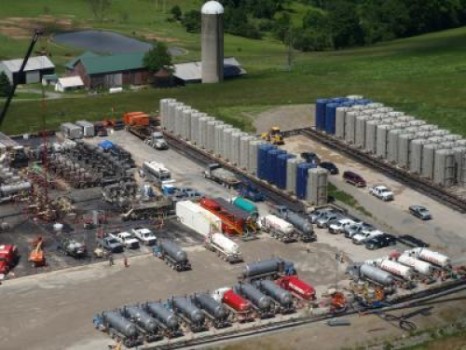
A strange thing happened on the way to dealing with climate change: Advances in hydraulic fracturing put trillions of dollars’ worth of previously unreachable oil and natural gas within humanity’s grasp.
The environmental costs — and benefits — from “fracking,” which requires blasting huge amounts of water, sand and chemicals deep into underground rock formations, are the subject of new research that synthesizes 165 academic studies and government databases. The survey covers not only greenhouse gas impacts but also fracking’s influence on local air pollution, earthquakes and, especially, supplies of clean water.
The authors are seven environmental scientists who underscore the real consequences of policy decisions on people who live near the wells, as well as some important remaining questions.
“Society is certain to extract more gas and oil due to fracking,” said Stanford environmental scientist Robert Jackson, who led the new study. “The key is to reduce the environmental costs as much as possible, while making the most of the environmental benefits.”
Fracking’s consumption of water is rising quickly at a time when much of the United States is suffering from drought, but extracting natural gas with hydraulic fracturing and horizontal drilling compares well with conventional energy sources, the study finds. Fracking requires more water than conventional gas drilling; but when natural gas is used in place of coal or nuclear fuel to generate electricity, it saves water. From mining to generation, coal power consumes more than twice the water per megawatt-hour generated than unconventional gas does.
Unconventional drilling’s water demand can be better or worse than alternative energy sources, the study finds. Photovoltaic solar and wind power use almost no water and emit no greenhouse gas, but cheap, abundant natural gas may limit their deployment as new sources of electricity. On the other hand, fracked gas requires less than a hundredth the water of corn ethanol per unit of energy.
Fracking’s impact on both climate change and local air pollution is similar to its impact on water, finds the study “The Environmental Costs and Benefits of Fracking,” published in the Annual Review of Environment and Resources.
Getting a fractured well going is more intense than for conventional oil and gas drilling, with potential health threats arising from increases in volatile organic compounds and air toxics.
But when natural gas replaces coal as a fuel for generating electricity, the benefits to air quality include lower carbon dioxide emissions than coal and almost none of the mercury, sulfur dioxide or ash.
Globally, though, relief to climate change is uncertain, the study finds. “While the increased gas supply reduces air pollution in U.S. cities downwind from coal-fired power plants, we still don’t know whether methane losses from well pads and pipelines outweigh the lower carbon dioxide emissions,” said Jackson.
In the eastern United States, fears of contaminated drinking water have raised more concerns than fracking’s water consumption. Gas and chemicals from humanmade fractures thousands of meters underground very rarely seep upward to drinking-water aquifers, the study says. The real threats are failures in the steel and cement casings of wells nearer to the surface and the disposal of wastewater, the study finds. Numerous previous studies have shown that casings fail between 1 percent and 10 percent of the time, depending on geology and well construction.
Cases of groundwater contamination have been hotly debated, but the new study finds that the overwhelming evidence suggests it has happened, albeit not commonly. Is the methane contamination observed in drinking water a precursor to other toxins — arsenic, various salts, radioactive radium and other metals — making their way up slowly? The researchers do not yet know. A few recent studies suggest the answer could be “yes” in rare cases.
How oil and gas companies handle wastewater — fluid used to fracture the shale that flows back up the well and water unleashed with the oil and gas — shows the importance of state policies. “Wastewater disposal is one of the biggest issues associated with fracking,” said co-author Avner Vengosh, a professor of geochemistry at Duke University.
Most fracking wastewater in the United States is injected deep underground, and an increasing amount is recycled for subsequent drilling or sent to advanced water treatment facilities. However, a handful of states still allow the wastewater to be used for watering cattle, sprayed onto roads for dust control or sent to municipal water-treatment plants not equipped to handle the chemicals involved.
All bad ideas, according to the authors of the new survey, who work at Duke University, MIT, Ohio State University, Newcastle University, Los Alamos National Laboratory, the National Oceanic and Atmospheric Administration and Stanford. One study they cite found that the agricultural use of fracking wastewater killed more than half of nearby trees within two years.
Injection of wastewater deep underground presents its own problems, the study finds. The practice occasionally has caused earthquakes strong enough to be felt by human beings, while the fracturing of shale miles below the surface rarely has done so. The dangers of seismicity can be reduced, however, if energy companies follow basic guidelines and undertake careful monitoring.
The study highlights several policies and practices that could optimize fracking’s environmental cost-benefit balance, and it highlights the need for further research. For example, the direct impact on the health of nearby residents is virtually unknown. “Almost no comprehensive research has been done on health effects,” said Jackson, “but decisions about drilling — both approvals and bans on fracking -are made all the time based on assumptions about health risks.”
Story Source:
The above story is based on materials provided by Stanford University. The original article was written by Mark Golden. Note: Materials may be edited for content and length.
Journal Reference:
- Robert B. Jackson, Avner Vengosh, J. William Carey, Richard J. Davies, Thomas H. Darrah, Francis O’Sullivan, Gabrielle Pétron. The Environmental Costs and Benefits of Fracking. Annual Review of Environment and Resources, 2013; 39 (1): 140822120156004 DOI: 10.1146/annurev-environ-031113-144051
